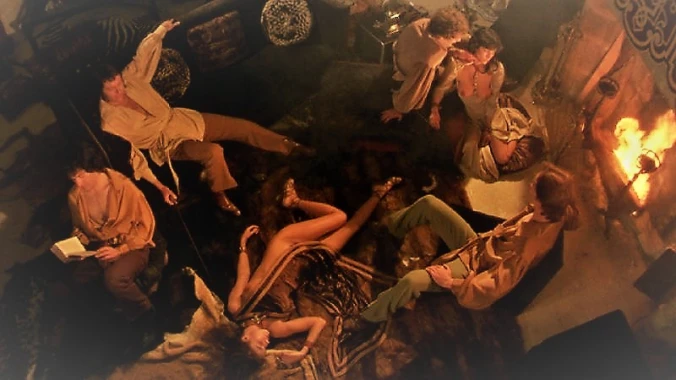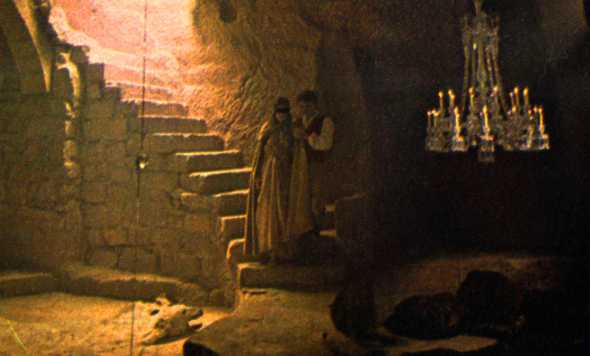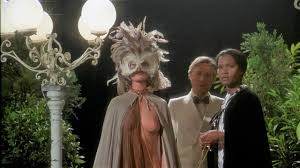The Story of O (1975)

The Story of O (1975) – A Bold and Controversial Exploration of Submission and Desire
The 1975 French erotic drama The Story of O (Histoire d’O), directed by Just Jaeckin, is one of the most controversial films of its time. Based on the novel of the same name by Pauline Réage, this film delves deep into themes of submission, dominance, and the psychological aspects of desire. With a striking visual style, an atmospheric score, and a captivating lead performance by Corinne Cléry, The Story of O remains an important, if divisive, work in the realm of erotic cinema.
Introduction: A Film That Redefines Eroticism
Few films have sparked as much discussion and debate as The Story of O. Upon its release, it was both praised for its boldness and criticized for its controversial themes. As a cinematic adaptation of one of the most infamous erotic novels ever written, it was bound to provoke strong reactions. The film explores the journey of a woman named O, who willingly submits to a series of trials designed to transform her into the ultimate object of desire.
With its dreamlike cinematography and unapologetic portrayal of sadomasochistic themes, The Story of O pushes the boundaries of erotic storytelling. But beyond the surface-level allure of its sensual imagery, the film also raises questions about the nature of love, power, and personal freedom.
Plot Summary: A Journey into Submission
The film follows O (played by Corinne Cléry), a beautiful fashion photographer who is deeply in love with her sophisticated and enigmatic lover, René (Udo Kier). At his insistence, she agrees to undergo training at a secluded chateau known as Roissy, where she is subjected to a series of increasingly intense acts of submission. Stripped of her identity and autonomy, O is conditioned to serve men without question, enduring physical and psychological trials that test the limits of her devotion.
After her initiation, René presents O to Sir Stephen (Anthony Steel), a more dominant and demanding master. O’s obedience is tested further as she is marked, pierced, and disciplined under Sir Stephen’s authority. As the story progresses, O seemingly embraces her transformation, finding a paradoxical form of liberation in submission.
Themes and Symbolism: Beyond the Surface
While The Story of O is often labeled as an erotic film, its deeper layers of meaning make it a fascinating study of human nature. It explores the paradox of submission as a means of achieving personal freedom. O’s journey raises profound questions about the nature of consent, the psychology of desire, and the dynamics of power within relationships.
- The Power of Submission – The film challenges conventional notions of dominance and submission, suggesting that true power lies in the ability to choose one’s fate. O willingly embarks on her journey, making her submission an act of agency rather than victimization.
- Love and Devotion – At its core, the film is about the lengths one is willing to go to for love. O’s actions are driven by her devotion to René, and later, to Sir Stephen. Her submission is not merely physical but an emotional and psychological sacrifice.
- The Role of Identity – O’s transformation involves shedding her former self to become an object of pure desire. The film explores whether one can find fulfillment in surrendering personal identity or if true empowerment lies in self-definition.
Cinematography and Direction: Aesthetic Beauty in Darkness
Director Just Jaeckin, best known for Emmanuelle (1974), brings his signature visual style to The Story of O. The film is beautifully shot, with an almost dreamlike quality that contrasts with its darker themes. The soft-focus cinematography and elegant framing elevate the film beyond mere exploitation, making it a visually stunning work of art.
The use of lighting and set design plays a crucial role in shaping the film’s atmosphere. The grandeur of Roissy, with its lavish yet eerie interiors, mirrors O’s transformation—a place of both enchantment and entrapment. The contrast between the soft, ethereal visuals and the harshness of O’s experiences creates a surreal juxtaposition that keeps the audience engaged.
The Performances: Corinne Cléry’s Brave Portrayal
Corinne Cléry delivers an incredibly brave and nuanced performance as O. She embodies a character who is both vulnerable and resolute, making her submission feel like a conscious choice rather than mere passivity. Her performance is essential in making the film more than just an exercise in eroticism—it becomes a compelling character study.
Udo Kier, as René, brings an enigmatic presence, though his role is more of a catalyst for O’s journey than a fully developed character. Anthony Steel’s portrayal of Sir Stephen is cold and commanding, embodying the strict discipline that O embraces. The dynamic between the three leads adds complexity to the film’s psychological exploration.
Cultural Impact and Controversy
Upon its release, The Story of O was met with intense controversy. Banned in multiple countries and heavily censored in others, the film was accused of promoting the objectification of women. Feminist critics argued that it glorified submission and male dominance, while others saw it as a powerful exploration of agency and personal choice.
Despite the backlash, the film has endured as a cult classic in erotic cinema. It has inspired countless discussions on the nature of BDSM relationships, the limits of consent in fiction, and the role of eroticism in art.
Comparison to the Novel
While largely faithful to Pauline Réage’s novel, the film inevitably simplifies some of its psychological depth. The novel provides more insight into O’s internal struggles and emotional transformation, while the film relies more on visual storytelling. Some of the book’s most controversial elements are softened, making the film more accessible but also less intense in its exploration of O’s psyche.
Legacy and Modern Perspective
In the modern era, The Story of O remains a divisive work. With the rise of mainstream BDSM depictions in films like Fifty Shades of Grey, there has been renewed interest in The Story of O as a precursor to contemporary explorations of power dynamics in relationships.
However, the film’s themes are far more extreme than today’s mainstream depictions of BDSM. Unlike the romanticized elements found in more recent films, The Story of O presents submission in a stark, uncompromising manner, making it both more challenging and more thought-provoking.
Conclusion: A Provocative and Unforgettable Experience
The Story of O (1975) is not a film for everyone. Its explicit themes and controversial subject matter ensure that it remains a polarizing work. However, for those willing to engage with it on a deeper level, it offers a unique and haunting exploration of love, power, and identity.
Whether viewed as an erotic masterpiece, an unsettling psychological drama, or an exploitative fantasy, The Story of O continues to be a significant and thought-provoking piece of cinema. Its legacy endures, reminding audiences of the power of film to challenge, disturb, and intrigue.